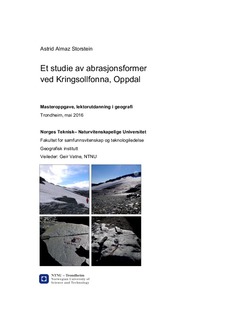| dc.description.abstract | In 2013, striations were discovered on the rock surfaces in front of the ice patch/small glacier Kringsollfonna, Oppdal. The small glacier had at this time shown little/no sign of movement. This thesis aims to examine the small scale landforms close to the small glacier. All striations, and other landforms of erosion, were mapped in September 2015. In an attempt to determine their origin, the compass measurements are reviewed in light of the available literature and applied to the interpretation. The striations are assessed on the basis of two possible flow patterns; 1) the north-eastern motion of Kringsollfonna, and 2) the north-western motion of the Scandinavian Ice Sheet in the late Weichsel.
The results show that the striations have two distinct directions, where one correlates with the Scandinavian Ice Sheet in the late Weichsel. The striations from this flow pattern are located on the rock surfaces south and south-east of Kringsollfonna. The other direction correlates with the incline of Kringsollfonna today and the expected flow pattern from the measurements in 2015. These striations are located in front of the ice margin of Kringsollfonna and indicate a polythermal or temperate thermal regime at the glacier bed at some point in the Holocene. | nb_NO |
